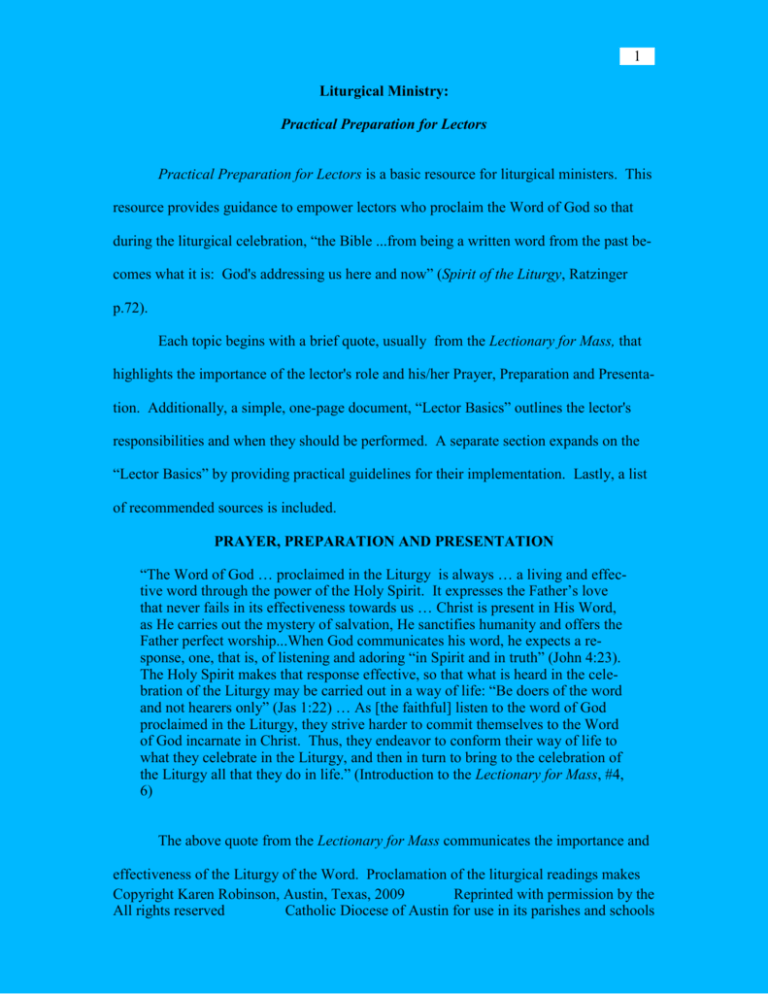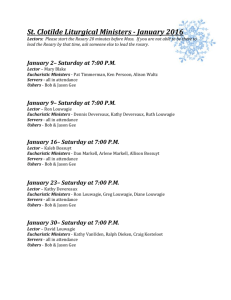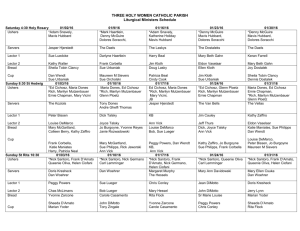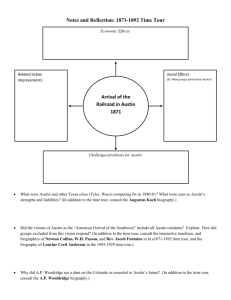
1
Liturgical Ministry:
Practical Preparation for Lectors
Practical Preparation for Lectors is a basic resource for liturgical ministers. This
resource provides guidance to empower lectors who proclaim the Word of God so that
during the liturgical celebration, “the Bible ...from being a written word from the past becomes what it is: God's addressing us here and now” (Spirit of the Liturgy, Ratzinger
p.72).
Each topic begins with a brief quote, usually from the Lectionary for Mass, that
highlights the importance of the lector's role and his/her Prayer, Preparation and Presentation. Additionally, a simple, one-page document, “Lector Basics” outlines the lector's
responsibilities and when they should be performed. A separate section expands on the
“Lector Basics” by providing practical guidelines for their implementation. Lastly, a list
of recommended sources is included.
PRAYER, PREPARATION AND PRESENTATION
“The Word of God … proclaimed in the Liturgy is always … a living and effective word through the power of the Holy Spirit. It expresses the Father’s love
that never fails in its effectiveness towards us … Christ is present in His Word,
as He carries out the mystery of salvation, He sanctifies humanity and offers the
Father perfect worship...When God communicates his word, he expects a response, one, that is, of listening and adoring “in Spirit and in truth” (John 4:23).
The Holy Spirit makes that response effective, so that what is heard in the celebration of the Liturgy may be carried out in a way of life: “Be doers of the word
and not hearers only” (Jas 1:22) … As [the faithful] listen to the word of God
proclaimed in the Liturgy, they strive harder to commit themselves to the Word
of God incarnate in Christ. Thus, they endeavor to conform their way of life to
what they celebrate in the Liturgy, and then in turn to bring to the celebration of
the Liturgy all that they do in life.” (Introduction to the Lectionary for Mass, #4,
6)
The above quote from the Lectionary for Mass communicates the importance and
effectiveness of the Liturgy of the Word. Proclamation of the liturgical readings makes
Copyright Karen Robinson, Austin, Texas, 2009
Reprinted with permission by the
All rights reserved
Catholic Diocese of Austin for use in its parishes and schools
2
present the living Word of God, Christ incarnate, and His salvific action in the world.
The Word manifests God’s presence, and through the actions of the Holy Spirit, has an
effect on the faithful community. Proclaiming God’s Words in the Liturgy is, in some
way, a mysterious participation in the accomplishment of God’s glorious work of salvation.
During the Liturgical celebration, it is the Lector’s humbling privilege and responsibility to be the human voice of God’s Living Word. Proclamation of the Mass’
Scripture readings is more than simply reading. The Lector’s proclamation engages the
community of faith and prompts their response to God’s Word. The proper exercise of
this important ministry requires Prayer, Preparation and Presentation. PRAYER
“It is out of the Word of God handed down in writing that even now 'God speaks
to his people ... The word of God proclaimed in the celebration of God's mysteries does not only address present conditions but looks back to past events and
forward to what is yet to come...The working of the Holy Spirit is needed if the
word of God is to make what we hear outwardly have its effect inwardly … the
Spirit brings home to each person individually everything that in the proclamation of the work of God is spoken for the good of the whole gathering of the
faithful.”(Introduction to the Lectionary for Mass, #7, #9)
Pray and meditate on the Scripture Readings. Be open to what the Holy Spirit is
saying. Consider:
What strikes you as you read the text?
What feelings or images are evoked by the text?
What is the message of the text?
What is the Spirit telling you?
What response is the Spirit calling for from me? From the community?
Are we being called to conversion, to repentance, to forgiveness, to belief, to God
and neighbor?
Copyright Karen Robinson, Austin, Texas, 2009
Reprinted with permission by the
All rights reserved
Catholic Diocese of Austin for use in its parishes and schools
3
When praying and practicing, make the message of the Spirit your own. Your
heartfelt, faithful response will be conveyed through your proclamation. The Spirit will
affect the open-hearted faithful assembly and enable each person to hear the unique message that s/he needs to hear. Their response will affect some change in the community’s
members that conforms them to Christ. PREPARATION
“It is Christ himself who speaks when the Holy Scriptures are read in the
Church…It is not enough that the biblical passages are read in the vernacular, if
they are not also proclaimed with the care, preparation, devout attention and
meditative silence that enable the Word of God to touch people’s minds and
hearts.” (John Paul II, Mane Nobicum Domine, 13)
Read all of the texts for that day’s Liturgy of the Word: the readings, the responsorial Psalm, the alleluia verse and the Gospel. Understand and pray about the content, purpose and message of the passages. Consider: How does the Psalm respond
to the first reading? How is the Gospel message connected to the other readings?
What is the theme of the day and the meaning or message that is conveyed?
Understand the readings in their Biblical context. Your understanding of the day’s
Scripture passages can be enhanced by reading the verses in the Bible that surround
the designated text. Biblical commentaries are helpful tools for the Lector’s deeper
understanding. (See bibliography for suggested commentaries.)
Understand the readings in their Liturgical context. (Readings can be found at
http://catholic-resources.org/Lectionary/1998USL.htm ). Become aware of how this
particular reading relates to the Scriptures that are read on the weekdays and Sundays prior to and following the reading you will proclaim. The readings generally
are complimentary or continuous, and reflect the Liturgical year. Consider: How
Copyright Karen Robinson, Austin, Texas, 2009
Reprinted with permission by the
All rights reserved
Catholic Diocese of Austin for use in its parishes and schools
4
does this passage make clear the theme of the surrounding days and the Liturgical
year?
Become familiar with the Lectionary. Read the introduction at the beginning of the
first volume. In particular, Chapter 4 “The General Arrangement of Readings for
Mass” and Chapter 5 “Description of the Order of Readings” can help the Lector
understand the choice and order of the readings throughout the liturgical year. The
3-year cycle of readings for Sunday Mass also can be found in the New American
Bible. This is the Bible translation used in the Lectionary. The Lectionary can be
found on-line at http://catholic-resources.org/Lectionary/Introduction-1981.htm.
Understand the text’s literary genre or style and consider its appropriate mood or
tone. The proclamation of a gifted Lector should be in keeping with the tone of the
passage. The Biblical author chose a particular literary style or genre to help convey
a specific purpose, message or theme with an appropriate mood or tone. Consider:
Is the passage part of a narrative (story)? Discourse (explanation or argument)?
Exhortation (persuasion)? Poetry (with metaphor and parable)? Is the tone joyful,
exultant or awe- inspiring? Encouraging or consoling? Is there repetition or opposition of thought? Practice proclaiming the text with the appropriate tone or mood in
mind.
PRESENTATION:
Practice and Proclamation
“A speaking style on the part of the readers that is audible, clear, and intelligent
is the first means of transmitting the word of God properly to the congregation.”
(Introduction to the Lectionary for Mass, #14)
Copyright Karen Robinson, Austin, Texas, 2009
Reprinted with permission by the
All rights reserved
Catholic Diocese of Austin for use in its parishes and schools
5
Know the message of the Sacred Scripture and why it is important. When proclaiming, focus your attention and energy on the intention of God’s Word. When the Lector consciously puts God's Word first, his/her demeanor will reflect an attitude of
service for God's Word and His people.
Your vocal presentation can help convey the message of the Scripture.
Practice by reading the Scripture conversationally. This may help convey the sense
of the text.
When practicing and proclaiming, speak more slowly than you would in normal
conversation.
Enunciate so that the assembly can understand all the words of God that you proclaim.
Pronunciation guides can be found in dictionaries and in your Lector’s handbook. If
you aren’t sure how to pronounce particularly difficult names of places or people,
then ask the celebrant, deacon or another liturgical minister.
Proclaim the Scripture expressively, not dramatically.
Vocal variety helps to engage the listener. Avoid a monotone voice.
Strive for a subtle variation in volume (loud or soft), pitch (high or low), tempo (fast
or slow) intonation (the rising and falling cadence of the voice), rhythm (the recurrent alternation of sound and silence that can provide emphasis) and inflection.
(Raise your vocal energy at the beginning of a new or significant thought or phrase.
The end of a sentence often calls for a downward inflection. Questions usually end
with an upward inflection.)
Copyright Karen Robinson, Austin, Texas, 2009
Reprinted with permission by the
All rights reserved
Catholic Diocese of Austin for use in its parishes and schools
6
Some words are more important than others. Emphasize important words by saying
them more slowly.
Misreading the text can occur. If you misplace a word or mispronounce it, just ignore your error and continue reading unless the sense of the text has been changed.
If your misreading has significantly altered the meaning of the text then correct it
immediately by re-reading the word, phrase or sentence so that the intended meaning is evident.
Manage anxiety. One’s desire to do well may heighten anxious feelings. Your confidence level will improve with preparation, practice and prayer. Use the energy associated with your anxiety by focusing yourself and your energy in the humble service of the Holy Spirit.
Proclaiming from the Ambo.
When proclaiming God's Word, Lectors praise and glorify God and engage in an
act of loving service for His faithful. The Lector provides the voice for the Holy
Spirit to make known the Word of God. So that the faith community hears God's
Word, the reader does not distract his fellow believers from the Holy Spirit's message. You are a servant of God's Word. Your manner, appearance and proclamation
should draw attention to the Scripture readings, not detract from them.
When standing at the ambo, the Lector's stance should project a sense of the importance of the proclamation. Be aware of your posture: stand straight, both feet
flat on the floor and shoulder-length apart, maintaining a secure but relaxed stance.
Fidgeting, repeatedly shifting your weight and inappropriate attire can be distracting.
Your relaxed hands can rest gently on the ambo or Lectionary. Discreetly and unob-
Copyright Karen Robinson, Austin, Texas, 2009
Reprinted with permission by the
All rights reserved
Catholic Diocese of Austin for use in its parishes and schools
7
trusively using your finger to mark your place when you read can be helpful. If necessary, adjust the height of the microphone.
Managing Pauses While Reading
Lectors can help their faith community connect to the Word of God by managing
pauses. Taking a breath while reading can create a brief pause. A Lector can use
this brief interlude to re-focus his attention and energy on humbly serving God and
community through his/her proclamations. Pauses convey meaning. Properly placed
pauses can convey the message, mood and weight of the text. Brief pauses can separate, emphasize, and conclude important thoughts, phrases or statements.
Mo-
mentarily pausing at key points in the reading can help the assembly understand the
text by creating a brief interlude for a message to “sink in” and be processed by the
listener.
Pause
according to the sense of the phrase or the sentence. Listening to yourself read the
passage aloud can help you sense when it is appropriate to pause. Punctuation
marks, commas, periods, etc.) can help you decide where to breathe. Mark your text
when a pause is appropriate. Practice pauses.
Carefully manage the
length of your pauses before and after a reading. Briefly pausing before beginning
the first reading's introductory words can allow time for the assembly to sit, get
comfortable and get ready to listen. A pause at this time also creates a brief moment
of expectation which invites the congregation's attention. Pausing at the end of a
reading invites a moment of silent reflection. Always pause at the end of the reading, before saying “The Word of the Lord”.
Engage the Assembly by Establishing Eye Contact
The proclamation of God's Word should affect a response from the community.
Copyright Karen Robinson, Austin, Texas, 2009
Reprinted with permission by the
All rights reserved
Catholic Diocese of Austin for use in its parishes and schools
8
The Lector can use eye contact with the assembly to invite their engagement, personal involvement, and response to the Words proclaimed. Eye contact can be used
to emphasize important phrases. Effectively engage the assembly by making eye
contact with different areas of the congregation – look slightly above the congregation, look towards the people in the back, and look slightly right or left of center.
Engage the whole assembly. Make eye contact at the beginning of the passage and
at the end of some sentences. While practicing, decide where in the reading it
would be natural to make eye contact.
LECTOR BASICS
o Arrive early
o Check in
o Look at the Lectionary on the ambo
o Be seated and pray until Mass begins
o Alternatively, participate in the entrance procession
o After the opening prayer, the assembly sits
o The first Lector approaches the ambo
o Lector manages a brief pause
o Lector looks at the congregation and makes eye contact
o Lector proclaims the ritual liturgical language “A reading from ...”
o Lector proclaims the first reading
o Upon completion of the first reading, the Lector pauses briefly, looks at
the faithful and begins the closing ritual dialogue “The Word of the Lord”
o Lector waits for the congregation's response “Thanks be to God”
o The Lector returns to her seat after a brief pause OR
The Lector remains at the ambo if s/he will be reading the responsorial Psalm
Copyright Karen Robinson, Austin, Texas, 2009
Reprinted with permission by the
All rights reserved
Catholic Diocese of Austin for use in its parishes and schools
9
o The Psalmist or Cantor proceeds to the ambo to proclaim or sing the Psalm
o The Psalmist or cantor begins with the response, then with a gesture prompts
the community to repeat the response.
o The Psalmist returns to his/her seat when the Psalm is concluded
o The reader of the second reading rises from her seat, approaches the ambo
and proceeds as for the first reading
o When a Lector has agreed to read the Prayers of the Faithful, the Lector
approaches the ambo immediately upon completion of the creed. The Lector
concludes each petition with “We pray to the Lord” The congregation
responds: “Lord hear our prayer”. PRACTICAL GUIDE FOR LECTORING
o Arrive early
Arrive in the Sacristy 15-20 minutes before Mass is scheduled to begin.
o Check in
Check in with the priest or other ministers so that they know you have arrived.
Inquire if something special will be added to the Mass between the opening
prayer and the first reading.
o Look at the Lectionary on the ambo
Prior to Mass, approach the ambo. The Lectionary should be on the ambo
and open to the first reading. Look at the text in the Lectionary so that you
become familiar with the format of the page from which you will actually read
o Be seated and pray until Mass begins.
Pray silently that you may humbly serve God and his people
o Alternatively, participate in the entrance procession
In some parishes you may be part of the opening procession. If so, take your
place behind the cross and candle bearers. When the procession reaches the
altar, make a simple bow of the head, then proceed to your seat. If you have
been asked to carry the Book of the Gospels in the opening procession, then do
so while holding the book upright with the lower corners cupped in your palms.
With your arms raised and elbows bent, hold up the book slightly above your
face. When the procession reaches the altar, place the Book of the Gospels
reverently upon the altar. Then, without bowing, go to your seat.
o After the opening prayer the assembly sits.
o The first Lector approaches the ambo
The first reader approaches the ambo after the opening prayer is concluded and
while the assembly is sitting down.
Copyright Karen Robinson, Austin, Texas, 2009
Reprinted with permission by the
All rights reserved
Catholic Diocese of Austin for use in its parishes and schools
10
o Lector manages a brief pause
Pause at the ambo and begin proclaiming the reading when the assembly is
ready and attentive. A moment of silence allows late-comers to be seated and
gives the assembly time to sit, get comfortable and become attentive.
o Lector looks at the assembly and makes eye contact
The Lector establishes eye contact, breathes and re-focuses his/her attention
and energy on proclaiming the Word of God.
o Lector proclaims the ritual liturgical language “A reading from ...”
While looking at the congregation, reverently proclaim the ritual language that
introduces the Scripture: “A reading from ...”
o Lector proclaims the first reading
It is helpful to memorize the introductory words and the first line of the reading
so as to maintain eye contact with the assembly. This helps keep the assembly
engaged and responsive.
o Upon completion of the first reading, the Lector pauses briefly, looks at
the faithful and begins the closing ritual dialogue “The Word of the Lord”
o Lector waits for the congregation's response “Thanks be to God”
The assembly responds “Thanks be to God”
o After a brief pause at the ambo for silent reflection, the Lector returns to
his/her seat.
o The Psalmist or Cantor proceeds to the ambo to proclaim or sing the
responsorial Psalm
The Psalm usually is sung by a Cantor at the ambo. However,
when it will not be sung, the Lector remains at the ambo and serves as the
Psalmist.
o The Psalmist (Lector) or Cantor begins with the response, then with a
gesture prompts the community to repeat the response.
The Psalmist begins by proclaiming the response. The congregation then
repeats the response. The Psalmist reads the Psalm verses and signals the
community to respond at the appropriate times. The Psalmist may use a simple
gesture to invite the community to respond. A gently raised hand, palm up and
held no higher than the shoulder, can be a gesture that invites response.
o The Psalmist/Cantor returns to his/her seat upon conclusion of the Psalm.
o The reader of the second reading rises from her seat, approaches the ambo
and proceeds as for the first reading.
o The second reader proclaims the reading while managing pauses,
establishing eye contact, and prompting the ritual dialog. At the
Copyright Karen Robinson, Austin, Texas, 2009
Reprinted with permission by the
All rights reserved
Catholic Diocese of Austin for use in its parishes and schools
11
conclusion of the second reading the Lectionary may be moved to the
ambo's lower shelf in order to make room for the Book of the Gospels
which the presider or deacon brings to the ambo. The Lector returns to
his/her seat.
o When a Lector has agreed to read the Prayers of the Faithful, the Lector
approaches the ambo immediately upon completion of the creed. The
Lector concludes each petition with “We pray to the Lord” The
congregation responds “Lord hear our prayer”.
Before the Prayers of the Faithful, the Lector's role as a proclaimer usually is
completed. However, when the Lector does read the Prayers of the Faithful
s/he should approach the ambo immediately upon completion of the creed.
After the petitions and the appropriate ritual dialog is complete, the Lector
returns to his/her seat.
RECOMMENDED READING
Catholic Resources, Lectionary http://catholic-resources.org/Lectionary/1998USL.htm
New American Bible: www.usccb.org/nab
A Simple Guide to the Daily Mass Readings. Chicago, Illinois: Liturgy Training
Publications.
Anchor Bible Dictionary. Des Moines Iowa: Anchor Bible, 1992.
At Home with the Word. Chicago, Illinois: Liturgy Training Publications.
The Catholic Bible, Personal Study edition: New American Bible. Jean Marie
Heisberger, general editor. New York, New York: Oxford University Press, 1995.
The Catholic Study Bible: Second Edition. Donald Senior and John J. Collins, editor.
New York, New York: Oxford University Press, 2006.
New Jerome Biblical Commentary. Upper Saddle River, New Jersey: Prentice Hall,
1989
Meagher, Virginia and Turner, Paul. Guide for Lectors. Chicago, Illinois: Liturgy
Training Publications, 2007.
Ratzinger, Joseph Cardinal. The Spirit of the Liturgy. Ignatius Press, San Francisco,
2000.
Rosser, OSB, Aelred. A Well-Trained Tongue: Formation in the Ministry of Reader.
Chicago, Illinois; Liturgy Training Publications, 1996.
Copyright Karen Robinson, Austin, Texas, 2009
Reprinted with permission by the
All rights reserved
Catholic Diocese of Austin for use in its parishes and schools
12
LITURGICAL MINISTRY: PRACTICAL PREPARATION FOR LECTORS
SAMPLE TRAINING SESSION
WHO SHOULD ATTEND:
All new and returning lectors should attend a training session, so that they will have a
firm grasp of their duties and responsibilities and when and how they should be performed. When lectors are prayerfully and properly prepared, they can more fully understand and execute their role as the human voice of God’s Living Word in the liturgical
celebration. Optimally, the person who will be training the lectors should be an experienced presenter and a well-trained lector. It is possible for the diocesan Director of Worship to recommend an appropriate person who can conduct the training sessions.
WHERE:
Ideally, training sessions for lectors should take place in the church or sanctuary, because
lectors will practice proclaiming from the ambo. (Additionally, they will practice pro-
Copyright Karen Robinson, Austin, Texas, 2009
Reprinted with permission by the
All rights reserved
Catholic Diocese of Austin for use in its parishes and schools
13
cessing while carrying the Book of the Gospels when it is the custom of the parish for the
lector to be part of the opening procession.).
WHEN:
Training sessions should be offered at a time when it is most convenient for busy individuals to attend. Training sessions should last two hours or less, depending upon the
number of lectors trained.
BLESSING:
Upon completion of training and after the lectors have followed the parish’s procedure
for committing to serve as lectors, the pastor may want to formally bless the ministers.
He may choose to administer a blessing at the end of the training session. Alternatively,
a blessing of liturgical ministers at weekend Masses gives the entire parish the opportunity to pray for these ministers. The diocesan Director of Worship can recommend an appropriate blessing.
Copyright Karen Robinson, Austin, Texas, 2009
Reprinted with permission by the
All rights reserved
Catholic Diocese of Austin for use in its parishes and schools
14
SAMPLE AGENDA FOR TRAINING SESSION
INTRODUCTION
Presenter introduces him/herself, welcomes the attendees, and thanks them for coming.
OPENING PRAYER
OVERVIEW:
Thank the trainees again for their time today. Tell them what you will be doing today:
You will be reflecting on the ministry of lectors; and on the importance of prayer, preparation, practice and presentation. You will model a way to practically prepare for your
Scripture reading by going through, step by step, what the lector does to prepare to proclaim the Word of God at Mass. Instruct them regarding the appropriate procedure to
sign up and get on the schedule to lector at Mass. Inform them of their term of service.
Copyright Karen Robinson, Austin, Texas, 2009
Reprinted with permission by the
All rights reserved
Catholic Diocese of Austin for use in its parishes and schools
15
For example, a lector may be committing to serve for one year, and their service term
may be renewable each year.
REFLECTION ON THE MINISTRY OF LECTORS
The lector is the human voice of God’s Living Word, who engages the community of faith and prompts their response through the actions of the Holy Spirit. The presenter can use the section of this document entitled “Prayer, Preparation and Presentation” for reflecting upon the lector as a servant of the Word of God, as one who proclaims
Christ, the living Word to his assembly.
REFLECT ON THE IMPORTANCE OF PRAYER
Use the section of this document entitled “Prayer” to help communicate the importance
of praying the Scripture readings. The presenter should choose a reading from the coming Sunday’s Liturgy. The presenter can use this reading to model how to effectively and
prayerfully read, reflect upon, and understand the Spirit’s message so as to conform one’s
heart and mind to the Lord. Begin by reading the Scripture passage two or three times,
then prompting the trainees to answer the questions posed in the section titled “Prayer”.
REFLECT ON THE IMPORTANCE OF UNDERSTANDING CONTEXT
Understanding the Biblical, liturgical and literary context of the Scripture passage that
will be proclaimed helps to uncover its meaning and message. The presenter can use the
section entitled, “Preparation”, which highlights the importance of context.
Copyright Karen Robinson, Austin, Texas, 2009
Reprinted with permission by the
All rights reserved
Catholic Diocese of Austin for use in its parishes and schools
16
REFLECT ON THE IMPORTANCE OF PRACTICE AND PROCLAMATION
Christ is present at the Mass in four ways: in the consecrated bread and wine, in the person of the priest, in the assembly, and in the proclaimed Word. The lector presents Christ
in his proclaimed Word. How the lector proclaims God’s Word can have a profound influence on the Spirit’s effect in the faithful assembly. The presenter can use the section
entitled, “Presentation: Practice and Proclamation” to emphasize effective practice and
presentation techniques. Be sure to communicate the following guidelines:
appropriate stance and attire, proclaiming from the ambo, managing pauses while reading, managing anxiety, engaging the assembly with eye contact, vocal presentation.
DISTRIBUTE HAND-OUT ENTITLED: Practical Guide for Lectoring
This hand-out documents exactly step by step what a lector does and when s/he does it.
Read through this hand-out with the trainees. This is a good time to answer any questions that arise.
DISTRIBUTE HAND-OUT ENTITLED: Lector Basics
The Lector Basics hand-out can be carried by the lector to Mass as a handy reference
guide. Ask for volunteers who would be willing to come to the ambo and proclaim the
Scripture reading that this group meditated upon earlier. One volunteer at a time will
proclaim the Word from the ambo. All will benefit from each other’s experience by offering positive and constructive comments, especially since both new and returning lectors will be present.
Copyright Karen Robinson, Austin, Texas, 2009
Reprinted with permission by the
All rights reserved
Catholic Diocese of Austin for use in its parishes and schools
17
Thank attendees for their time, and remind them of the appropriate procedure to sign
up and get on the schedule to lector at Mass.
Copyright Karen Robinson, Austin, Texas, 2009
Reprinted with permission by the
All rights reserved
Catholic Diocese of Austin for use in its parishes and schools









